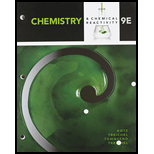
Interpretation:
The four different molecules are given in the statement and which is one diamagnetic character, and correct molecule should be identified.
Concept Introduction:
Paramagnetic: The Paramagnetic properties are due to the presence of some unpaired electrons, and from the realignment of the electron paths caused by the external magnetic field.
Diamagnetic: The molecule or atoms have paired electrons in respective shell, this type of alignments diamagnetic.
Bond order: The bond order has defined as the net number of bonding electrons pairs linking a pair of atoms. This same concept can be applied directly to molecular orbital theory, but not bond order is defined as.
Trending nowThis is a popular solution!

Chapter 9 Solutions
Bundle: Chemistry & Chemical Reactivity, Loose-Leaf Version, 9th + OWLv2, 4 terms (24 Months) Printed Access Card
- (i) What is the covalency of N in N2O5 ?(ii) Explain why phosphorus forms pentachloride whereas nitrogen andbismuth do not?arrow_forwardUsing an MO energy-level diagram, would you expect F2 to have a lower or higher first ionization energy than atomic fluorine? Why?arrow_forwardWhy is CN^1- not an acceptor (pi) as good as CO, even though they are isoelectronic?arrow_forward
- How many of the following species are paramagnetic?Cd2+, Se, Ti2+, Br-arrow_forwardWhich is the most stable electron configuration for the iron(III) ion, Fe3+? (A) [Ar] 4s2 3d3 (B) [Ar] 4s1 3d4 (C) [Ar] 3d5 (D) [Ar] 3s2 4p3arrow_forwardThe reason behind Cations that have inert gas configuration seems to have greater polarizing power on anions than those do not have inert gas configuration (like transition metals and periods 4 and higher elements in group IIIA)arrow_forward
 Chemistry: An Atoms First ApproachChemistryISBN:9781305079243Author:Steven S. Zumdahl, Susan A. ZumdahlPublisher:Cengage Learning
Chemistry: An Atoms First ApproachChemistryISBN:9781305079243Author:Steven S. Zumdahl, Susan A. ZumdahlPublisher:Cengage Learning
 ChemistryChemistryISBN:9781305957404Author:Steven S. Zumdahl, Susan A. Zumdahl, Donald J. DeCostePublisher:Cengage Learning
ChemistryChemistryISBN:9781305957404Author:Steven S. Zumdahl, Susan A. Zumdahl, Donald J. DeCostePublisher:Cengage Learning


